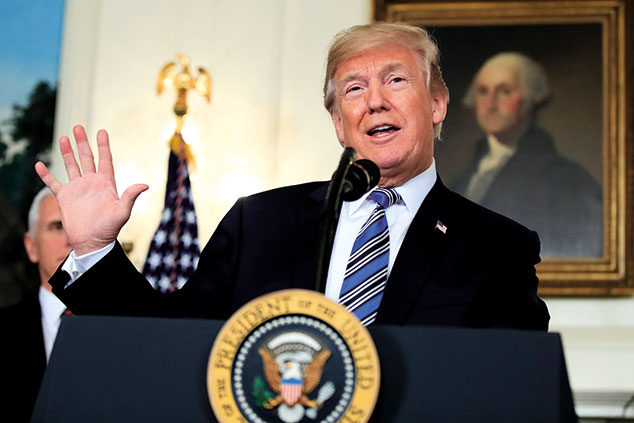
US tariffs could trigger a tit-for-tat trade dispute, damaging global growth. Alex Rankine reports.
Donald Trump has already pulled America out of the Trans-Pacific Partnership and the Paris climate-change agreement, says The Economist’s Buttonwood column. “Now he appears determined to roll back the international trade arrangements that have been in place since 1945.” The president has announced that he will impose tariffs on $60bn of Chinese exports to the US, a move that threatens to spark a trade war between the world’s two largest economies.
Trump is determined to eliminate America’s $375bn trade deficit with China, but tariffs will make scant difference, not least because his tax cuts, by stimulating consumption of imports, will widen the gap. “The most likely route for eliminating the deficit would be a recession in which the US lost its appetite for imports; not something markets (let alone the voters) would welcome.”
Don’t panic just yet
China has responded cautiously to the tariffs, notes Tyler Cowen on Bloomberg View. Beijing has announced a “$3bn tariff retaliation, 1/20th of the initial amount”. It is seeking “reconciliation rather than escalation”. With Chinese growth slowing Xi Jinping is probably willing to “ignore some of Trump’s antics” for the good of the national economy. In any case, the $60bn in tariffs represents less than 3% of China’s global exports and is forecast to lower its GDP by as little as 0.1%.
Talk of a trade war is “premature”, agrees George Magnus in the FT. “The current salvos could yet be the prelude to talks between the White House and Xi Jinping’s newly installed government.” Washington says that the measures are necessary because of China’s theft of American intellectual property. The “hidden agenda” is more likely to be a desire to frustrate China’s “ambitious industrial policy goals” to develop world-leading capacity in sectors such as IT, aerospace and new energy vehicles.
As for the trade deficit with China, it is “not as simple as it looks”, says Magnus. Rather than $375bn, the 2017 deficit was actually “nearer $150bn” when factoring in China’s position at the end of many supply chains. Many goods are shipped in from countries including Japan and South Korea to be completed and re-exported, so part of the deficit is really between the US and suppliers in other countries. “Throw in the US services trade surplus, and the number drops to about $110bn… still large but not as punchy politically.”
Trump is playing to the gallery
The White House is right to want to take Beijing to task over unfair trade practices, but these tariffs will prove counter-productive, says Paul Krugman in The New York Times. “If you want to pressure China into respecting intellectual property, you need to assemble a coalition of nations hurt by Chinese rip-offs.” Instead, Trump is “systematically alienating those countries” with his recent tariffs on steel and threats to penalise goods assembled in China but mainly produced elsewhere. By bumbling into a trade war, the White House is managing to “lose friends while failing to influence people”.
The president’s claim that “trade wars are good, and easy to win” is “preposterous”, concurs David Dodwell in the South China Morning Post. The tariffs will land US consumers with dearer imports and risk retaliation against US exporters of everything from soya and beef to Boeing aircraft. Yet Trump’s real priority is November’s midterm election. By firing up his core supporters with this posturing on trade he hopes to preserve Republican majorities in Congress. Little of the economic pain from a trade war will feed through until 2019. “Meanwhile, he has an election to win.”